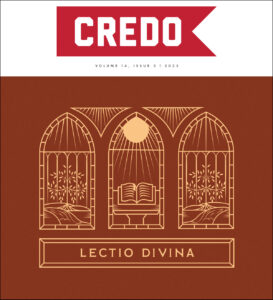F rom the time I first began biblical studies as a young undergraduate, the tension between a devotional reading and a historical-grammatical reading of Scripture has haunted me. I have never once doubted the inspiration of the Bible. In my entire Christian life, it has always been a source of comfort and encouragement and a place of divine encounter. The Bible is the Word of the LORD, speaking to God’s people fresh words in our modern lives. But it’s also a historically grounded book. It was written by a people in a time and place under vastly different circumstances than mine in middle Tennessee. What am I to make of this? To read the Bible ahistorically leads to damaging theology at worst and silly platitudes at best. Yet to read it as nothing more than a historically limited collection of writings is troublesome as well. It can make the text static, irrelevant, and unable to offer a fresh word from God today. Wedding these two ends of the spectrum can feel like fitting a square peg in a round hole or, more appropriately, attempting to get some churches to change the color of their sanctuary’s carpet—it can’t be done! Or can it?
rom the time I first began biblical studies as a young undergraduate, the tension between a devotional reading and a historical-grammatical reading of Scripture has haunted me. I have never once doubted the inspiration of the Bible. In my entire Christian life, it has always been a source of comfort and encouragement and a place of divine encounter. The Bible is the Word of the LORD, speaking to God’s people fresh words in our modern lives. But it’s also a historically grounded book. It was written by a people in a time and place under vastly different circumstances than mine in middle Tennessee. What am I to make of this? To read the Bible ahistorically leads to damaging theology at worst and silly platitudes at best. Yet to read it as nothing more than a historically limited collection of writings is troublesome as well. It can make the text static, irrelevant, and unable to offer a fresh word from God today. Wedding these two ends of the spectrum can feel like fitting a square peg in a round hole or, more appropriately, attempting to get some churches to change the color of their sanctuary’s carpet—it can’t be done! Or can it?
In Piercing the Clouds: Lectio Divina and Preparation for Ministry, the contributors argue not only that historical-grammatical and devotional readings of Scripture can happen together but that they should happen. Especially in the spiritual formation of budding Catholic priests. Drawing on the writings of the early church, medieval monks, and Pope Benedict XVI, they offer six essays building their case. With titles ranging from “Western Monastic Tradition of Lectio Divina” and “Seminary Formation to Exquisitio, Supplicatio, Praedicatio: Searching the Scriptures and the Mystery of Preaching,” there is plenty within these pages to be relevant for seminarians across ecclesial boundaries. In what follows I offer a summary of the core arguments and prescriptions of the book followed by a brief analysis.
Suggested Prescriptions
First, Laurence Kriegshauser argues that if we are to understand the resolution to this problem, we must first discover the source of it. Kriegshauser finds this source toward the end of the twelfth century with the rise of new scholasticism. Before this period, monastic theology dominated the landscape, offering “a theology completely grounded in the loving exploration of sacred Scriptures.” Much of which was grounded in various forms of lectio divina, instructing monks to navigate through the four stages of lectio, meditatio, oratio, and contemplatio, Or reading, meditation, prayer, and contemplation, respectively. Each step oriented toward bringing the monk into a deeper encounter with God. Consider the steps as expounded by Prior Guigo II, “reading seeks for the sweetness of the blessed life, meditation perceives it, prayer asks for it, contemplation tastes it.”
With the rise of new scholasticism, Kriegshauser argues, theology “shifted its attention to rational analysis and systemization,” marking a “departure from the interior, affective theology of the patristic and monastic Fathers.” Scripture came to be used to justify rational arguments and moral lessons more than as a vehicle to achieving communion with God. The Bible was used primarily in a deductive manner, dissected like a cadaver, not encountered like a living source. Citing Marie-Dominique Chenu, the reading of Scripture “was before anything else an exegesis; i.e., an interpretation attempting to explore the objective substance of a text, whatever the subjective needs or the results obtained…The word of God was treated as an “object”… apart from one’s own fervor and experience.”
From this foundation, the remaining essays seek to recover a reading of sacred Scripture grounded in lectio divina but not at the neglect of a critical engagement with the text. The latter of which has been the dominate mode since the rise of new scholasticism. The most robust engagement with this comes in the volume’s longest essay by Konrad Schaefer, “Lectio Divina Fosters Growth and Formation.” Schaefer relates what Pope Benedict calls “a profound fissure between scientific exegesis and lectio divina,” to the nature of music. Music is a language with two natures. One can be well versed in musicology, analyzing “acoustics, resonances and….music theory” but fail to capture “the spiritual nature of the subject.” The depth of meaning and emotional resonance of music cannot be reduced to analysis. It has to be performed and encountered. “Music, like the Word of God in human language, has two natures, the physical score, sound, the instrument and the art of the musician, which is coupled with the second nature, the spirit of the performing art.”
Schaefer offers prescriptions to reconcile these two natures. The first is for readers to follow Moses’s lead at the burning bush and remove their sandals. We must recognize that the Bible’s landscape is holy ground where we encounter one who is wholly other. Quoting Monteiro da Silva, “It was necessary for Moses to put his feet on the bare ground, to sense the quality of his own nakedness before a reality that far surpassed his capacity for understanding.” When we come to the Bible in all its mysteries, languages, and historical complexities, it’s appropriate to realize that we’re encountering the same God Moses encountered at the burning bush. What is needed is “historical criticism complemented by friendship with God.”
A second prescription offered by Schaefer is to fall in love with reading. He advocates for a program that grants space for seminarians to “cultivate reading enjoyment” because “[l]iterature is the companion of the mind and the imagination.” Schaefer believes that by reading the greatest pieces of literature such as Walker Percy, Graham Greene, Mark Twain and more, seminarians “might develop a taste for spiritual reading, the Bible, and even patristics. One hopes to awaken in him sensitivity to plot, characterization, symbolic language, the poetry of the psalms, and themes that will enrich their lectio.”
Finally, a Lectio Seminar “of the Old and New Testaments, with texts selected from the current year of the Sunday lectionary” is proposed. In this seminar, students walk through the lectionary texts together in “the careful, prayerful study of the texts, situating them in their possible historical contexts…with the aim of illuminating the life and conversion of the participants.” In this way, seminarians can learn what transformative, exegesis-informed lectio looks like.
An Educational Model
While holding the central spot in this collection, Schaefer is not alone in offering prescriptions for developing a lectio-informed priesthood. Laurence Kriegshauser offers some suggestions based on his experience at Kenrick-Glennon Seminary. Once a week, seminarians gather for a time of lectio where a Gospel passage is read aloud and participants are given ample quiet time to listen for what the Lord might be speaking to them. Then, they’re invited to share their personal reflections. This seminary also provides students with a booklet called WRAP Yourself in Scripture that walks readers through 4 simple steps of lectio. Finally, lectio is woven into class assignments in various departments. In these ways, priests are introduced to a prayerful and contemplative encounter with Scripture throughout their education. By creating paths for seminarians to practice lectio divina in class while developing a love for imaginative reading, more seminarians would flourish educationally, spiritually, and vocationally. Click To Tweet
A final prescription can be found in Daniel Keating’s reflection on Benedict’s inclusion of actio in the process of lectio divina. After explicating the importance of the usual four steps of lectio divina, Benedict writes that we “do well to remember that the process of lectio divina is not concluded until it arrives at action (actio), which moves the believer to make his or her life a gift for others in charity.” Keating argues that we must have a lectio that moves us to action which arises naturally “from reading, prayer, and contemplation.” As we seek to inculcate lectio divina into priestly formation, we can not do so at the expense of moving outward toward our neighbors.
Taken together, Piercing the Clouds offers a compelling case for the necessity of incorporating lectio divina in the formation of clergy. It is an unfortunate saying that “seminaries are cemeteries” where student’s faith can drift away through calculated, critical reading of Scripture. Important as critical engagement is, it cannot be divorced from friendship with God. What the church needs today are Catholic priests—and Protestant clergy—who are molded by exegetically-informed lectio so as to better love their God and those under their care.
I believe that the prescriptions in this volume offer a starting point in this endeavor. If more seminaries—Protestant and Catholic alike—are intentional to weave lectio divina into the formation of their students, then more of our churches would be become places where Jesus is encountered through the Scriptures and his presence felt. By creating paths for seminarians to practice lectio divina in group settings, class assignments, and seminars while developing a love for imaginative reading, more seminarians would flourish educationally, spiritually, and vocationally.


